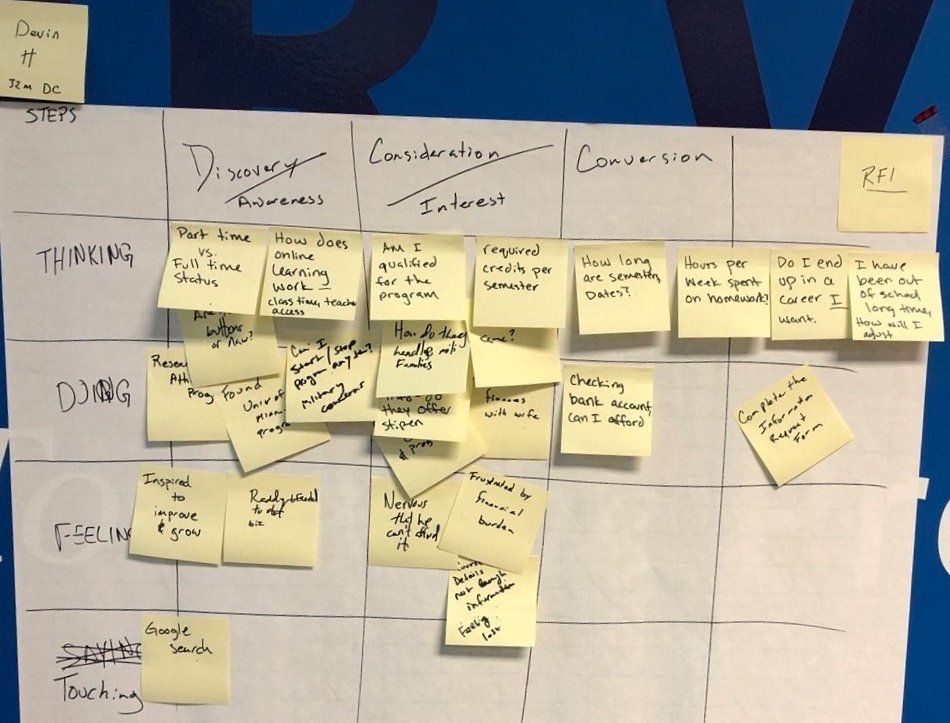GETTIN’ SCRAPPY WITH IT… DEVELOPING A CONTENT STRATEGY FOR THE UNIVERSITY OF MIAMI
UX Design / Content Audit / Content Strategy / UX Research
Organization: Unleashed Technologies
Client: University of Miami & Laureate University
What: UX Guerrilla Research and Content Audit for the Masters in Sports Administration Online Program
Role: UX Researcher, Strategist, Proposal Writing & Design, Client Presentation, Project Management
Goal: Develop a comprehensive audit and review the U of M Masters in Sports Administration program content.
Stakeholders Involved: Institutional Program Adminstrators, Content Marketing, Sales
OVERVIEW
Approached to develop a comprehensive content audit and review of the University of Miami’s (U of M) Masters in Sports Administration online program, Unleashed Technologies was presented a critical growth opportunity for their nascent strategic design discipline. Leading this project with a high constrained delivery timeline, Ithe end-to-end delivery of was tasked with identifying strategies to improve the user experience for prospective students by outlining a plan to boost inquiries and enrollments through the interaction and communication of the course.
THE CONSTRAINT: TRUST
This was the first real UX project Unleashed Technologies had taken on and there wasn’t much knowledge within the agency on what was needed or expected from the work. As the self-appointed UX evangelist and value advocate I knew I’d need to lead by example to build trust in the process, this required a high-level of preparation, some imaginative thinking, and resourcefulness to gain buy-in from my team and get things right.
PART 1: A STRUCTURE OF UNDERSTANDING
FOCUSING OUR ENERGY
To start, the goal was centered around understanding the overarching purpose and goals of the organizations involved, so as to work with empathy and in accordance to their mission. We verified some of the core business issues, which was accomplished through regular interviews with executive (product owner, c-level, etc.) and ancillary (customer support, account, and sales reps) stakeholders. Using information garnered from this early interview and research period, I worked to develop a unified goal, along with a plan of action using KPIs (Key Performance Indicators) to identify realistic measures of success, and KSAs (Key System Attribute) to identify the means in-which success would be attained.
We targeted the key admissions conversion opportunities, using them as a end points to investigate and map within the application journey for the online Sports Administration program.
CASTING OUR CHARACTERS
During this early stage I was simultaneously delving into the U of M’s analytics, using web traffic data to identify potential pain-points for investigation. Merging demographic data, be it historical based on the institution’s existing enrollment rosters, quantitative using Google Analytics demographics and affinity data, and/or qualitative engaging U of M’s ancillary stakeholders in guerrilla research sessions to gain context on the data I was uncovering. Using these details I built two user personas that told the story of perceived student types informed through our interview and data insights.
PART 2: IMAGINING THE STORY
Using the insights gathered and digging through US regional and state-level employment data helped provide a sense of what students from different walks of life may be encountering as they look to enroll into the U of M Online Master’s program. Providing empathy and context for the person’s situation or mindset when they look to enter the program, so that the University staff had a better understanding of the role they may plan in student’s day-to-day lives.
BUILDING THE JOURNEY
With personas developed, my team began to examine the user journey through two key conversion points (RFI submissions, and Live Chat interaction) to understand where user pain-points lie within the content, design, and hierarchy of the U of M Masters in Sports Administration.
With no research budget and limited timelines to work, I needed to find a way to gain perspective of a potential user’s journey. In order to accomplish this I ran journey mapping workshops with co-workers, assigning them with the personas, and instructions for examining the U of M website in the mindset of the target users, we then role-played in the sessions mapping the journey for the user’s.
PART 3: EVALUATING THE CONTENT
SPEAKING TO THE AUDIENCE
Upon completion of the user persona and journey development phase, I began a focused audit of the U of M’s Masters in Sports Admin program website, outlining issues revolving around content structure, information architecture, user experience, and a host of other pitfalls that may hamper success. Also developed was a list of suggestions and best practices—aligned with the previously approved KPIs & KSAs—that they could take advantage of to meet their underlying goals.
Collaborating with my internal sales and marketing team, along with an outside content strategy consultant, we developed a comprehensive audit and set of recommendations that they could target for improving the experience of prospective students.
PART 3: GUIDING THE PATH FORWARD
CONCLUDING THE AUDIT
We concluded the project presenting our journeys, findings and insights, content calendar and marketing strategy to the client, to a resoundingly positive response. Since the introduction of this audit, many of the suggestions have been implemented, with the content calendar, user personas and journeys providing an ongoing source of insights helping them improve the user experience throughout their online programs.
Additionally, this audit helped Unleashed Technologies to secure Laureate University and the University of Miami as a longer-term client, securing a $1+ mil/yr contract to help advance the brand’s growth efforts; supporting social media communications, webinar and training graphics.
KEY TAKEAWAYS
If risk of harm is low, assumptions are reasonable starting points, so long as you acknowledge the research debt it incurs, staying mindful to research and (in)validate those assumptions whenever possible.
Even a little research is useful, throughout this project I employed scrappy research methods to understand the user environment or the internal pain points that arose as a result of end user problems.
Cross-functional collaboration is needed early and often, this is even more true the tighter the deadline.














